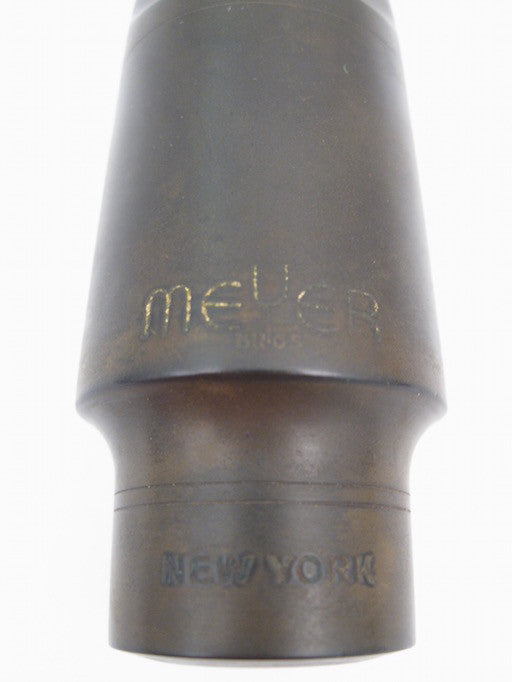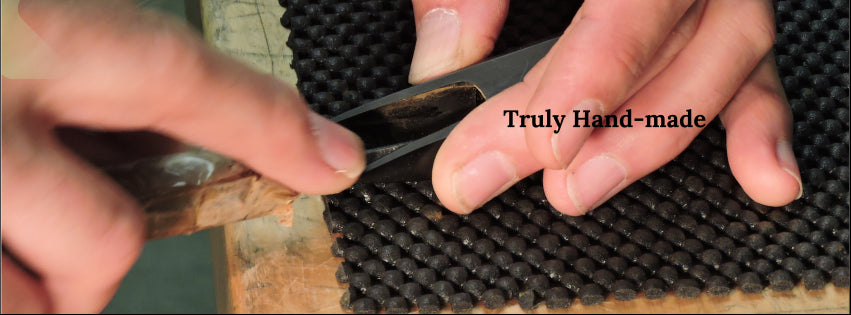
Meyer Bros 5M Alto Mouthpiece vs Morgan Jazz 6M Alto Saxophone Mouthpiece
Author: David Hoskins
Recently, the long-time owner of this Meyer Bros New York 5M Alto Saxophone Mouthpiece tried a Morgan Jazz 6M and decided to part ways with his beloved Meyer simply because, as he stated, “The Morgan plays better”.
Physically, there are many similarities between the two mouthpieces. Both are high quality rubber mouthpieces. Both have medium round chambers; however, the Morgan M Chamber is a bit smaller than the Meyer Bros Medium chamber. Whereas, the Morgan ML Chamber is very similar to the Meyer Bros Medium Chamber. Both mouthpieces have roll-over baffles. The Meyer 5M tip opening measures .075 as does the Morgan 6M.
Both the Meyer Bros and the Morgan have nearly identical facing curves. While there are practically infinite possibilities for facing curves, it’s no coincidence that the facing curves of the Meyer Bros and the Morgan are nearly identical. There are optimal facing curves which maximize the efficiency of reeds. Frank and Ed Meyer knew this and so did Ralph Morgan. We recently found notes from a master class Ralph taught on the subject and we will be posting articles about this in the future.
Ralph started the Morgan Mouthpiece Company with the purpose of bringing back the lost art of handmade chart-designed saxophone and clarinet mouthpieces. Much of the inspiration for his line of saxophone mouthpieces came from the Meyer Brothers, M.C. Gregory and Otto Link.
It is not just the physical properties of the mouthpieces which are similar…it’s the process and philosophy in how they are made.
The following segment is from an early brochure from Frank and Ed Meyer:
“When you play your instrument, you are not interested in a thousandth of an inch, or the proper rubber formula, or the post-cure time for the castings. You are interested, however, in results, results which enhance your playing, and perhaps increase your earning power. We (on our design board, in our molding room, and in our workshop) are also interested in the results which
you get on the job. But, in order to provide you with the finest mouthpieces money can buy, we must be scientifically accurate down to a degree of temperature, and the tenth of a thousandth of an inch. There is no place in the world where clarinet and
saxophone mouthpiece making has been so thoroughly investigated and refined. In no other plant has the element of hand-craftsmanship and sheer pride, as well as years of mouthpiece specialization, been so grounded in each and every product. More cannot be said.”
While this statement was made by the Meyer Brothers, it could have easily been made by Ralph Morgan.
Let’s break this down a bit and show the similarities between the manufacturing process & philosophy of the Morgan Company and the original Meyer Bros Company.
“Thousandths of an inch”…This is probably not much different among mouthpiece manufacturers. Many mouthpiece makers can get facing curves and tip openings accurate to a thousandth of an inch. While It is debatable if a skilled craftsman can cut a facing curve as accurate and consistent as a machine, a skilled craftsman can certainly do the job and many top quality mouthpieces are still faced by hand. The Morgan mouthpiece is all hand-crafted and all facing curves and tip measurements are accurate to a thousandth of an inch.
“Proper rubber formula”…Ralph always claimed that his formula was the same as those used by mouthpiece manufacturers of the 1940s / 1950s. It is a very simple pure rubber formula with no additives or synthetics. It is the most basic and pure formula that can be used to create a hard rubber product. Quite likely, this is a similar formula that was used by the Meyer Bros Company and many others back then. It was a time before cheaper synthetic fillers were added to the rubber compound. Ralph once told me that when he presented his “simple” formula to the rubber engineer for the first time, the engineer didn’t believe that it would produce a suitable hard rubber product. Ralph told him, “I know it will, because that’s what we used in the 1940s.” We, at the Morgan Company, control the formula of the rubber used to make our products. There are no added synthetic fillers in our rubber. I wonder how many other mouthpiece makers know the actual ingredients of their rubber. Many makers order rod rubber or castings from sources outside of their company. Do they know what their rubber is made of? Do they have any control? Would they know if the rubber changed?
“Post-cure time for castings”…When making a casting from a mold, there are a many considerations. Meyer Bros created and owned the molds to make their mouthpieces. We also created and own our own molds and the castings from our molds are exclusive to the Morgan Company.
An interesting consideration which most manufacturers probably do not consider is the type of press used. Ralph insisted on using old steam presses rather than more modern electronic presses. He claimed that the old pre-WWII steam presses produce a more consistent product and that more modern presses can leave soft spots in the castings. As steam presses were commonly used in the 1940s and 1950s, most likely, the Meyer Bros Company used similar steam presses in their molding process and just like the Meyer Bros Company, we control the time and temperature of the presses during the molding process.
The other part of the curing process is the post-cure baking process. This process is done in ovens at precise temperatures and durations. The hardness of rubber is measured by a Durometer using a Shore-D scale. Ralph claimed that a precise Shore-D measurement is important to the consistency of mouthpieces. There is a range on the Shore-D scale which a mouthpiece casting needs to be in order to maintain the accuracy of the facing curve. Within that range, the hardness of the rubber affects the tonal brightness and darkness of the mouthpiece. Most likely, Ralph’s cure times are similar to the cure times of the Meyer Bros to produce castings with similar shore-D hardness ratings. Just like the Meyer Brothers, the Morgan Company controls the curing temperatures and times for our castings and thus controls the shore-D hardness of the rubber used. Again, I wonder how many mouthpiece makers know the shore-D rating of their rubber and is it consistent from batch to batch?
“Element of hand-craftmenship”...The Meyer Bros Company certainly had skilled craftsmen. The Morgan Company has three craftsmen (Erik Greiffenhagen, John MacQueen, and Brian Powell) which have combined experience of 80+ years and are among the best in the World. After the casting is released from the mold, it barely resembles a mouthpiece.

From this point on, the mouthpiece is completely hand-crafted using hand tools, files, sandpaper, etc. As one of our skilled craftsmen work a mouthpiece, he can identify problems and solve them or discard a casting if necessary…a machine cannot make those decisions. A machine will finish an imperfect casting and send it out for sale…a skilled craftsman will not. A skilled craftsman can get a table flatter than a machine. As a machine cuts, it heats the rubber which causes it to expand and then contract when it cools. As a result, often tables are not flat and facing curves are not accurate. A craftsman cuts much more slowly causing a lot less heat which allows for flatter tables and more accurate facing curves. The only machines used by our craftsmen are an electric engraver for the logo and a buffer for a final polish.
"There is no place in the world where clarinet and saxophone mouthpiece making has been so thoroughly investigated and refined.”
Ralph Morgan started working for the Babbitt Company when he was 9 years old! He apprenticed under his father at the Conn Company, worked at several Elkhart musical instrument companies and spent most of his adult career at the Selmer Company and retired as Chief Woodwind Designer. He started the Acoustic Research Laboratory with David Bilger in the early 1980s to continue to study and research mouthpiece design and materials. He wrote countless articles and gave master classes on mouthpiece design. He started the Morgan Mouthpiece Company in 1980 and we continue his legacy 35+ years later.
"In no other plant has the element of hand-craftsmanship and sheer pride, as well as years of mouthpiece specialization, been so grounded in each and every product. More cannot be said.” This statement could easily be said today by anyone at the Morgan Company.
While there are differences between the Meyer Bros 5M and the Morgan Jazz 6M, they have more in common than they differ. The early Meyer Bros Company and the current Morgan Company share many similarities in process, philosophy, control, quality and craftsmanship. The Morgan Company continues to make truly hand-crafted traditional-style mouthpieces the “old fashioned” way because we believe these methods still produce the best mouthpieces ever made. Like Ed and Frank Meyer, we control our formula, processes, molds, facing tolerances, post-cure times, temperatures, and we have top craftsmen.
This particular player decided that he will never play the Meyer Bros piece again since "the Morgan plays better", thus his decision to part with the Meyer. We ended up purchasing the Meyer Bros mouthpiece and we will be selling it on eBay. We will sell it using eBay id: morganmouthpieces It will probably sell for $1700+ and it will be a great mouthpiece for someone. If you don't win the auction, you can purchase a Morgan Jazz Model in your choice of facing and chamber for $240-$260 and have a mouthpiece made with similar rubber, manufacturing process, experienced craftsmen and rest assured that your $240 mouthpiece is every bit the quality mouthpiece as the $1700+ Meyer Bros. Plus, If you purchase the Meyer Bros and drop it, it may take years to find another. If you drop the Morgan, you can probably get another one before your weekend gig!



Hideya "Bonz" Satoh says...
Played Meyer created in 70’s for over 20 years. I got my horn stolen so as the mouthpiece around 1995. Right after that, I had to buy another alto sax & mouthpiece. One of my friend suggested me to try Morgan Mouthpiece and I’ve been using the same Morgan Mouthpiece since then. Morgan Mouthpiece comes with so many sound variation out of same 1 mouthpiece.
Meyer’s 100 years edition mouthpiece recently came out and I liked it. But, after playing for about few weeks, I found that Morgan plays musically sound better. I will stick with my Morgan.
Bonz
On Sep 09, 2019
Maria José nascimento says...
I am loking for a mouthpiece brand Meyer with specs nr 5 for alto sax.
Are you the manufacturer?
Please send me more specs and price and how to buy it though internet.
Thank you
On Jun 26, 2019
Maria José nascimento says...
I am loking for a mouthpiece brand Meyer with specs nr 5 for alto sax.
Are you the manufacturer?
Please send me more specs and price and how to buy it though internet.
Thank you
On Jun 26, 2019
Andy says...
I have had the pleasure of owning and playing Morgan mouthpieces for years.
They really are exceptional pieces.
On Jun 26, 2017
Israel says...
Hello, I went through your home page but I couldn’t see the prices of the of your product. kindly send to me the price list of your alto saxophone mouth piece and their ranges.
Thank U
On Jun 22, 2017
Zacharias Elia says...
Dear sir I have been told Morgan clarinet mouthpieces company has actually closed down .Is this true? Thanks Zacharias
On Jun 08, 2017
MICHAEL MITCHELL says...
Is there scientific equations for Designing mouthpieces
On Sep 16, 2016
Mike Holt says...
Thank you Ralph
Yes I have several of your pieces for the various horns over 20+ years
And I just trust them
On Sep 05, 2016
David Sanford says...
Having been on the blowing end of a few Morgans, I agree with the statement that the Morgan plays better. Also a thing of beauty to look at. Makes me smile every time i play!
On Aug 25, 2016